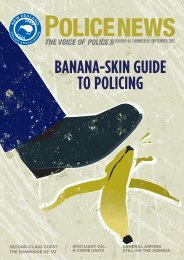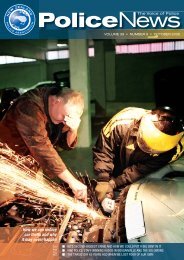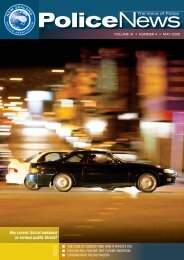Police News June 09.indd - New Zealand Police Association
Police News June 09.indd - New Zealand Police Association
Police News June 09.indd - New Zealand Police Association
You also want an ePaper? Increase the reach of your titles
YUMPU automatically turns print PDFs into web optimized ePapers that Google loves.
<strong>New</strong> <strong>Zealand</strong> <strong>Police</strong> <strong>Association</strong>Stolen car expert says Govt’s scrapping ofwhole of vehicle marking is “short-sighted”By Steve Plowman, Editor, <strong>Police</strong> <strong><strong>New</strong>s</strong>The Government’s decision to scrapa scheme that was touted as being apotential world leader in reducingcar thefts has been criticised as “shortsighted and ill-conceived” by a <strong>Police</strong>car theft expert.The Whole of Vehicle Marking Scheme(WOVM) involves the application of thevehicle’s identification number acrossmuch of a car, using micro-dottingtechnology.Over 32,000 cars were stolen in <strong>New</strong><strong>Zealand</strong> last year – that’s an average ofone every 25 minutes. Vehicle theft is thesecond biggest crime in <strong>New</strong> <strong>Zealand</strong>.Annually around 7,000 cars are notrecovered and of these an estimated 85%are stolen by organised professional carthieves, who use sophisticated ‘chop’shops to turn the cars into parts. Theseare sold on the lucrative stolen partsmarket, which generates $80 million ayear for organised crime.Previous Government’s backingThe previous Labour Governmentdecided in December 2004 to introduceWOVM, as part of a comprehensivepackage of vehicle theft reductioninitiatives. This involves sprayingvarious parts of all newly registeredvehicles with over 7,000 microdots,each containing a car’s unique vehicleidentification number (VIN).The WOVM programme was lauded atthe time as a chance for <strong>New</strong> <strong>Zealand</strong>to show the world what could bedone to fight vehicle crime using newtechnologies.The cost of microdotting the cars withWOVM is around $80.Imposition of additional costsTransport Minister Steven Joyce said thatthe Government was “very mindful” ofimposing additional costs on consumersin tough economic times. But critics saythat a one-off cost of $80 for the life of avehicle is a small price to pay for peaceof mind. Treasury estimates the life of acar at 20 years – meaning that WOVMwould cost each motorist $4 a year.Insurance companies spoken to by <strong>Police</strong><strong><strong>New</strong>s</strong> have indicated that they would bewilling to reducepremiums forvehicles sprayedwith the uniquemicrodot paint.In announcing thescrapping of thescheme, Mr Joycesaid the potentialbenefits of it would• Transport Ministerbe significantly Steven Joyceoutweighed by the announced that thecost to motorists. Whole of VehicleMarking (WOVM)But critics of the scheme had beenGovernment’s scrapped by theposition say that Government.two cost-benefitstudies had been carried out, bothproving that WOVM had a positivecost-benefit.Cost efficientMr Joyce said that it was “far more costefficient” to add security features at thepoint of manufacture, rather than aspart of the importing process.Senior Constable Mark Gibson ofWellington, a former motor vehicletheft expert with the Organised CrimeUnit, who has worked in the field for 26years, told <strong>Police</strong> <strong><strong>New</strong>s</strong> that the decisionwas a real blow for policing.“I have spoken to detectives who havebeen around this job from the days whenMark 1 Cortinas and Minis were beingstolen and stripped, and they have alltold me that there has never been anyway of identifying stolen parts, whichare then transferred to other vehicles.Then WOVM came along – the bestcrime-fighting tool we have had in themotor vehicle theft arena and now wefind out it’s not a goer. I am gutted.”Exponential flow-on effectMr Gibson said the thinking behindcanning the WOVM scheme wasextremely short-sighted. “What theyforget is that it’s the exponential flowon of the vehicles that are sprayedwith the data dots that will make themtraceable for around 20 years. Once thewhole fleet had WOVM it would be atremendous saving.”He said that data dots could eventuallysave police an enormous amount of timeand resources because they had thepotential to become mainstream assecurity devices on anything of value thatcould be targeted by burglars or thieves.“They open up a window of possibilitiesin crime fighting that we have never hadpreviously,” he said. Mr Gibson said thereal value of data dot technology is that itwould allow not only police officers butmembers of the public to identify stolencar parts very quickly by checking themagainst a <strong>Police</strong> register. “That’s the wayit was moving with WOVM for thefuture,” he added.One of the Government’s arguments infavour of scrapping the scheme was thatthe majority of vehicles now come fittedwith immobilising technology, whichprevents a car running unless the correctkey is present. It says this has resulted inthe number of car thefts droppingsubstantially. Car thefts decreased by6.9% in the last reporting year between2007 and 2008.Deterrent effectHowever, Gibson says that whileimmobilizers have a deterrent effect onthe opportunistic end of the car theftmarket, they do not deter organisedcrime syndicates looking to steal highend,expensive model cars to order.Gibson again: “The reality of it is thatyes, a lot of vehicles are coming intothe country with immobilisers and thatis excellent but the organised crooksaren’t stupid, they see a car parked upa driveway or outside a house and theymake sure no one is home and thenburgle the house. Where are you goingto find the car keys? Probably on thebedside table, on the fridge or a keyhook and they steal them and then thecar is gone, immobiliser or not. That’swhere Whole of Vehicle Marking comesinto its own.”Whole of Vehicle Marking is estimatedto have decreased thefts of high-end carsbetween 63% and 92%.The Government is considering anew Land Transport Rule that wouldrequire new and recently manufacturedimported cars to be fitted with an engineimmobiliser before they can enter thevehicle fleet.<strong>June</strong> 2009127

















